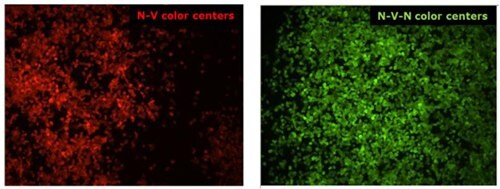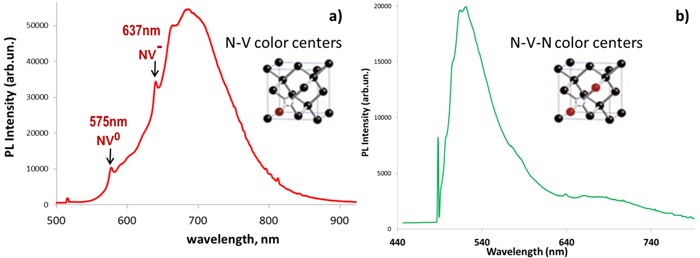Fluorescent Nanodiamond Particles: Properties and Applications
Dr. Olga A. Shenderova
President, Adámas Nanotechnologies, Inc.
Introduction
Nanodiamond (ND) particles are increasingly being utilized as diagnostic, imaging, and therapeutic agents in biomedicine,1 for cryptography and quantum computing in quantum information processing, and as single-spin sensors in nanomagnetometry.2,3 Most of these applications are based on the unique optical and magnetic properties associated with point defects in diamond. Due to the presence of wide-bandgap, NSs often contain atomic defects or impurities, some of which are highly luminescent making them useful as fluorescent, cathodoluminescent or photoacoustic imaging agents.1 NDs are highly biocompatible and have inherently low cytotoxicity and genotoxicity.1
Fluorescent Nanodiamond (FND) Optical Properties
Nitrogen is the most common impurity in diamond, incorporated into the crystal lattice as isolated substitutional nitrogen atoms or two nearest-neighbor substitutional nitrogen atoms, among other numerous N-containing defects. Vacancies trapped by nitrogen atoms form different color centers, depending on the type of N state in diamond. The nitrogen-vacancy (N-V) defect, responsible for diamond’s red/near-infrared fluorescence, and nitrogen-vacancy-nitrogen (N-V-N) color centers (or H3 centers), with bright green photoluminescence, are the optically active defects that have received the most consideration (Figure 1).1-3 The N-V center is a defect formed in the diamond by one substitutional nitrogen atom and an adjacent vacancy, while N-V-N center consists of a nitrogen-vacancy-nitrogen complex (Figure 2). Vacancies can be produced by irradiating NDs with high-energy particles. Consequent annealing at high temperature causes vacancy diffusion and formation of color centers with nitrogen atoms.

Figure 1.The fluorescence of diamond is based on color centers incorporated into the diamond lattice: nitrogen-vacancy centers (N-V), provide red fluorescence (left) and N-V-N (or H3 center) emit green light (right).

Figure 2.Photoluminescent emission spectra of 100nm ND particles containing N-V centers (a) and N-V-N centers (b) dispersed in DI water at a concentration of 1mg/mL. Excitation wavelength is 532nm and 442nm, correspondingly. Peak at 488nm (b) corresponds to Raman shift of diamond.
The optical properties of the N-V center are well suited for bioimaging applications, with optical excitation from 490–560 nm and emission in the red\near infrared (637–800 nm) (Figure 2a), away from most autofluorescent cell components. The emission occurs in a spectral window of low absorption attractive for biological labeling due to greater penetration of light in the surrounding tissue. The spectra of N-V centers exhibit a zero-phonon line (ZPL) at 638 nm for the negatively charged defect (N-V-) and a ZPL at 575nm for the neutral state (Figure 2a). The intensity of the luminescence from the NDs containing NV centers depends on the number of N-V centers in a particle. For example, 100nm NDs may have PL brightness exceeding the brightness of the Atto 532 dye by more than an order of magnitude, when compared side-by-side under identical conditions using total internal reflection fluorescence microscopy measurements. The H3 center emits green fluorescence with a maximum around 530 nm (Figure 2b) when excited by blue light. A remarkable feature of N-V and N-V-N centers is that they do not photobleach or blink even under continuous high energy excitation conditions4 making them superior to conventional chromophores owing to their unprecedented photostability.
The negatively charged NV center in ND particles has also emerged as an important system for quantum sensing.2,3 Since the spin state of the N-V- center can be optically detected in conjunction with magnetic resonance protocol using optically detected magnetic resonance (ODMR), and the state of the spin is sensitive to the surrounding magnetic field, a ND particle containing a single N-V- center can be used as an ultrasensitive magnetometer working at ambient conditions. Besides magnetic fields, N-V- centers demonstrate high sensitivity to electric fields, temperature and strain.2,3
Nanodiamond Surface Chemistry
Since color centers are embedded within the diamond matrix their fluorescence properties are not affected by surface modification.1 Although the surface of bulk diamond has been considered to be chemically inert, NDs typically contain numerous oxygen-containing surface functional groups (i.e., -COOH, -OH, carbonyls, esters, etc.) that are introduced during purification using strong oxidizers or generated by a reduction reaction (for example, using lithium aluminum hydride, LiAlH4).5 ND can be also purified using etching of sp2 carbon by hydrogen. Facile surface functionalization has been accomplished by chemical, photochemical, mechanochemical, enzymatic, plasma and laser assisted methods.5 The use of strong chemical treatments or extreme temperatures (i.e., autoclaving for sterilization or liquid nitrogen for storage) render the NDs suitable for medical use without degrading the crystalline structure (sp3 bonding) of the core. Due to multiple methods of surface functionalization, NDs can be readily incorporated into other matrices useful for binding biological entities such as proteins, enzymes, hormones, antigens, DNA, or drugs via both electrostatic and covalent interactions.6 For example, encapsulation of fluorescent NDs within a lipid layer enhances the diffusion of the particles in the cytoplasm by more than one order of magnitude.7 The surface of the ND is amenable to derivatization with a variety of organic functional groups for subsequent linkage with bio-active molecules, making it well suitable for diagnostic and therapeutic applications. High targeting specificity of FND in different cell assays was demonstrated for FND covalently conjugated with streptavidin, to which biotin-labeled antibodies of interest were linked.8 To avoid nonspecific labeling, use of bovine serum albumin (BSA) as a stabilizing agent is recommended, providing high resistance of diamond nanoparticles coated with BSA to flocculation in phosphate-buffered saline.9
Applications
The first reported use of FNDs for in vitro biological labeling appeared in 2005,10 demonstrating that FNDs containing N-V centers can be spontaneously internalized by cells and have very low toxicity. The brightness and stability of the fluorescence of these diamonds made them suitable for single particle tracking within cells.4 The stable fluorescence from diamond allows long term optical tracking and nanoscale sensing. Improved image contrast of NDs in cells can also be achieved through time-gated detection of the N-V center fluorescence11 taking advantage of the long-lived fluorescence lifetime, up to ~20 ns, of ND which is substantially longer than the lifetime, ~3 ns, for cell and tissue autofluorescence.
The perfect photostability of FNDs enabled super-resolution imaging by stimulated emission depletion (STED).9 High resolution three dimensional imaging can be readily achieved in real time. Using STED microscopy single FND particles (~30 nm) were distinguished in cells with sub-diffraction resolution of approximately 40 nm.9
Multiphoton excitation imaging is a powerful tool which allows tissue imaging in living organisms with longer penetration depths. It excites a fluorophore at the focus spot thereby reducing cell autofluorescence. Additionally the microscopy provides better image contrast and lower photodamage to cells. The presence of single FND particles (~40 nm) in cells was detected using a femtosecond infrared laser.7
The spin property of the N-V- centers, the optically detected magnetic resonance, was used to improve the image contrast of FNDs in vitro and in vivo and overcome the problem of autofluorescence caused by endogenous molecules.12,13 In wide-field fluorescence imaging in vivo alternating microwave irradiation modulated only the fluorescence intensity of the N-V- center, while the background fluorescence remained constant. Image processing effectively removed background autofluorescence signals and significantly improved the image contrast.12 In an alternative approach the modulated magnetic field was used to achieve background-free wide-field imaging of N-V- centers in NDs located in sentinel lymph node.14 The image contrast was improved by nearly two orders of magnitude. Certain color centers in NDs possess cathodoluminescence and remain stable under prolonged electron-beam exposure, providing valuable labels for bioimaging based on correlative light and electron microscopy (CLEM). Color images of green and red FNDs in living HeLa cells were obtained using a CLEM microscope15 revealing structural details with excellent spatial resolution in living biological systems. This demonstrates that they may advance clinical diagnostic sensitivity.
In summary, NDs containing color centers possess bright fluorescence without photobleaching and blinking, which, in combination with their biocompatibility and facile biofunctionalization make NDs ideal bioprobes for molecular imaging and cell labeling. The unique combination of spin and photoluminescent properties of certain types of color centers in NDs open new bright perspectives in discovering new methods of bioimaging and sensing based on ND’s color centers.
References
To continue reading please sign in or create an account.
Don't Have An Account?